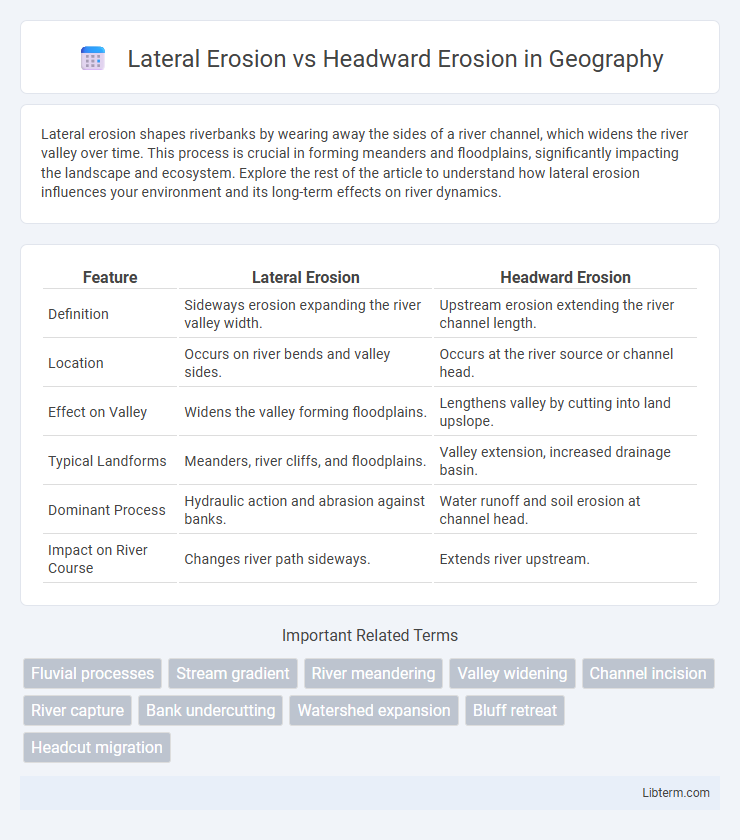Lateral erosion shapes riverbanks by wearing away the sides of a river channel, which widens the river valley over time. This process is crucial in forming meanders and floodplains, significantly impacting the landscape and ecosystem. Explore the rest of the article to understand how lateral erosion influences your environment and its long-term effects on river dynamics.
Table of Comparison
| Feature | Lateral Erosion | Headward Erosion |
|---|---|---|
| Definition | Sideways erosion expanding the river valley width. | Upstream erosion extending the river channel length. |
| Location | Occurs on river bends and valley sides. | Occurs at the river source or channel head. |
| Effect on Valley | Widens the valley forming floodplains. | Lengthens valley by cutting into land upslope. |
| Typical Landforms | Meanders, river cliffs, and floodplains. | Valley extension, increased drainage basin. |
| Dominant Process | Hydraulic action and abrasion against banks. | Water runoff and soil erosion at channel head. |
| Impact on River Course | Changes river path sideways. | Extends river upstream. |
Understanding Erosion: Key Concepts
Lateral erosion primarily occurs along riverbanks, widening the valley by removing soil and rock sideways, which shapes meanders and floodplains. Headward erosion takes place at the origin of a stream channel, extending the length of the stream by cutting into the land upstream, often leading to the formation of new drainage channels. Understanding these erosion types highlights how river landscapes evolve through both horizontal widening and upstream lengthening processes.
What is Lateral Erosion?
Lateral erosion refers to the sideways wearing away of riverbanks, which widens the river valley and creates floodplains. It occurs primarily in the middle and lower courses of a river, where the water flows more slowly and has greater energy for side-to-side movement. This process contrasts with headward erosion, which extends the river channel upstream, deepening and lengthening the river valley.
Defining Headward Erosion
Headward erosion is the process by which a stream channel lengthens at its source, cutting back into the landscape and extending the river's origin upstream. This erosion occurs by the removal of soil and rock at the head or uppermost part of a stream channel, causing the stream to migrate backward into the drainage area. In contrast, lateral erosion widens the stream valley by eroding the banks along the sides of the channel, primarily shaping the valley rather than extending the river length.
Geological Processes Behind Lateral Erosion
Lateral erosion primarily occurs along the sides of river channels, driven by the hydraulic action of flowing water and the sediment load that abrades riverbanks, leading to a widening of the valley floor. This process contrasts with headward erosion, which extends the length of the river channel upstream through soil and rock removal at the waterfall or the river's source. The geological mechanisms behind lateral erosion involve the weakening of riverbank materials by turbulent flow, undercutting, and mass wasting, which reshape the river valley into broader floodplains over time.
Factors Influencing Headward Erosion
Headward erosion is primarily influenced by factors such as the slope gradient, stream discharge, and the type of bedrock or soil through which the stream cuts. Higher gradients increase the velocity of water flow, accelerating erosion at the source, while more erodible materials like loose sediment promote faster headward retreat. Vegetation cover and climatic conditions, including rainfall intensity and frequency, also significantly affect the rate of headward erosion by altering surface runoff and soil stability.
Impacts of Lateral Versus Headward Erosion on Landscapes
Lateral erosion primarily widens river valleys by eroding the banks, leading to the formation of floodplains and meanders that significantly reshape the surrounding landscape. Headward erosion extends the length of a stream channel by eroding land at the source, contributing to the development of new drainage areas and altering watershed boundaries. The combined impacts of lateral and headward erosion drive landscape evolution by modifying landforms, influencing sediment transport, and affecting ecosystem habitats.
Typical Environments for Lateral and Headward Erosion
Lateral erosion predominantly occurs in the middle and lower courses of rivers, where the channel meanders through flat floodplains, leading to the widening of valleys and formation of features like oxbow lakes. Headward erosion is typical in upland or hilly regions, where streams erode their source area backwards, extending their length and often contributing to the development of deep V-shaped valleys and watershed expansion. Both erosion types are fundamental in shaping different river landscapes, with lateral erosion sculpting broader valleys and headward erosion carving new drainage paths.
Visual Indicators: Identifying Each Erosion Type
Lateral erosion is visually identified by the widening of river valleys, characterized by undercut banks and meandering curves along the river sides, which indicate sideways erosion. Headward erosion presents as the extension of a stream channel's source, visible through features like steep valley heads, retreating waterfalls, and a lengthening stream course. Distinguishing these erosion types involves observing river morphology changes, where lateral erosion dominates valley broadening and headward erosion drives upstream landscape expansion.
Differences and Similarities Between Lateral and Headward Erosion
Lateral erosion occurs along the sides of a river channel, deepening and widening the valley, while headward erosion takes place at the river's source, extending the channel length upstream. Both processes contribute to valley formation and landscape change by removing soil and rock but differ in direction and impact area. Together, lateral and headward erosion shape river courses, influencing floodplains and drainage patterns through continuous sediment transport.
Significance of Erosion Types in River and Landform Development
Lateral erosion primarily widens river valleys by eroding banks, creating floodplains and meanders that shape extensive landforms. Headward erosion extends the river length by eroding the source region, contributing to watershed expansion and the formation of steep valleys or gullies. Both erosion types play crucial roles in river morphology and landscape evolution, influencing sediment transport and ecosystem habitats.
Lateral Erosion Infographic

 libterm.com
libterm.com